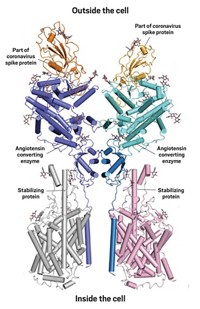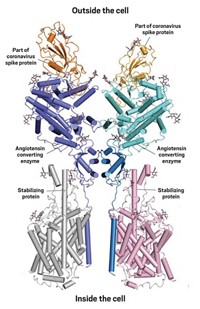Advertisement
Grab your lab coat. Let's get started
Welcome!
Welcome!
Create an account below to get 6 C&EN articles per month, receive newsletters and more - all free.
It seems this is your first time logging in online. Please enter the following information to continue.
As an ACS member you automatically get access to this site. All we need is few more details to create your reading experience.
Not you? Sign in with a different account.
Not you? Sign in with a different account.
ERROR 1
ERROR 1
ERROR 2
ERROR 2
ERROR 2
ERROR 2
ERROR 2
Password and Confirm password must match.
If you have an ACS member number, please enter it here so we can link this account to your membership. (optional)
ERROR 2
ACS values your privacy. By submitting your information, you are gaining access to C&EN and subscribing to our weekly newsletter. We use the information you provide to make your reading experience better, and we will never sell your data to third party members.
Biological Chemistry
HIV Takes A Punch
Clearer picture of how antibodies bind to HIV surface protein could lead to vaccine
by Sarah Everts
February 15, 2007
A chink discovered in HIV's seemingly impenetrable armor may provide the structural insights needed to develop a vaccine.

Researchers at the National Institutes of Health, Scripps Research Institute, and Harvard Medical School combined forces to solve the X-ray structure of a powerful blocking antibody as it binds to a vulnerable spot on HIV's envelope protein (Nature 2007, 445, 732).
Figuring out how these potent antibodies block virus infection gives researchers a blueprint for designing a vaccine that could spur the human immune system to do the same.
The work is a "huge advance," comments Warner C. Greene, director of the Gladstone Institute of Virology & Immunology at the University of California, San Francisco. "This type of data could greatly inform future efforts" to design vaccines, which he describes as a "long-stymied" venture.
"After years of disheartening results, people started thinking that a vaccine was not possible," says coauthor Peter D. Kwong of the National Institute of Allergy & Infectious Diseases. "This result says, 'No, it's not impossible.' "
Although HIV's external coat evolves rapidly, thereby allowing the virus to side step many neutralizing antibodies made by the human immune system, it does have one weakness: Because HIV must bind to a human protein receptor known as CD4 to enter our cells, the virus's human-recognition moiety must stay constant.
Kwong and his colleagues discovered this moiety in 1998 when they solved the structure of the HIV protein in contact with CD4. At the time, the solution seemed to be just around the corner because they understood the binding interface. The problem is that HIV carefully protects its own Achilles' heel.
The binding interface is protected on the cell side by a carbohydrate shield, Kwong says. "On the other side, HIV proteins change shape a lot. It's called being 'protected by conformational masking.' "
"The more structural work we did, the more defenses we found," he adds.
Antibodies from HIV patients turned out to be the solution. Some HIV-infected individuals who don't show disease progression produce potent antibodies that target HIV's weak spot, although far too late to avoid the initial infection. But these antibodies suggest that the virus can be neutralized. Next, researchers needed to know how. The 10 hydrogen bonds between the antibody and the HIV protein seen in Kwong's structure provide a molecular motif that those designing a vaccine will need to emulate.
The next step is for researchers to create mimics of this binding site and then present the mimics more efficiently to the immune system so that it can churn out antibodies that target HIV's Achilles' heel, says immunologist Joseph G. Sodroski of Harvard Medical School. "It's quite nice to see the veil pulled back and to see exactly how this antibody has managed to evade HIV's defenses."
A second blow to HIV was delivered last week by researchers reporting a new way that retroviruses, in general, travel from infected cells to healthy ones (Nat. Cell Biol., DOI: 10.1038/ncb1544). After infecting a cell, retroviruses, including HIV, spur the production of a sticky membrane protein that attracts, then binds to, thin extensions called "filopodia" from nearby healthy cells, says Walther Mothes, a virologist at Yale University. HIV particles then use these filopodia bridges to transport themselves to uninfected cells. The molecular mechanisms by which the bridge forms could enlighten strategies to prevent HIV's further distribution in the body.





Join the conversation
Contact the reporter
Submit a Letter to the Editor for publication
Engage with us on Twitter